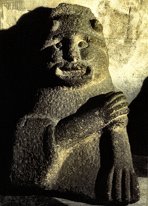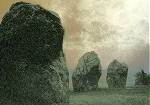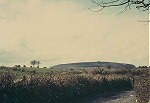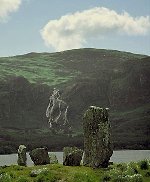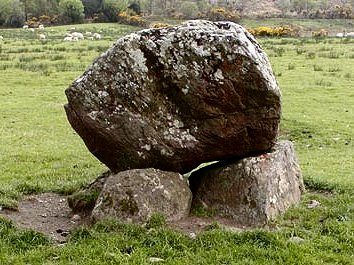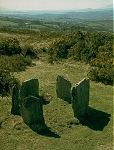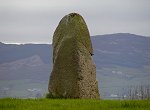|
the
earth-mother's
|
text and photographs
by Anthony Weir
|
But circles were being built in the north-west of Ireland at least a couple of hundred years before the dramatic edifices of Britain. These were circles of boulders deriving from the kerbs of the passage-tombs which were constructed in large numbers on good low-lying farmland. But, as with Portal-tombs, the often diminutive Irish circles are in wonderful locations, complementing rather than dominating the beautiful and even dramatic landscapes they are surrounded by as no later architecture has ever set out to do, much less achieved. Many are hard to find, but once found, are a delight to the eye in their marriage of landscape with the near-paranoia of human consciousness. Unlike Britain (whose finest examples are at Brodgar on Orkney and Castlerigg in Cumbria), the largest Irish circles tend to be - as ever with Irish architecture - the least beautiful. They also not only imitate earthen henges, but in some cases are enclosed by henges or earth-banks. These large Neolithic circles have many stones - sometimes set cheek by jowl - and are 30 metres and more in diameter. Some have alignments on the southern moon, others on the equinoctial sunset. The Irish circles of the Early Bronze Age, however, are much smaller and quite unlike British examples such as Callanish, Avebury and Stonehenge. They could have been erected by rather small groups of people - even single extended families. Many are only roughly circular. And some are intimately associated with alignments or Stone-rows and circles filled with stones. The bulk of Irish stone circles belong to the Middle Bronze Age, and are often very small indeed. We can see and feel, without the teleologies of excavation, pollen analysis, dendrochronology, carbon-dating, and so on, that the many stone circles (and perhaps also stone rows), are magical and ceremonial constructions: open-air temples or observatories. The word
temple derives from Latin templum, whose original
meaning was 'viewing-space'. It
seems more than likely that prehistoric tombs and stone circles
were templa for some kind or kinds Those of the Middle Bronze Age were erected at a time of climate-deterioration in areas of marginal soils which had never before been exploited and exhausted: the uplands of counties Cork and Kerry, Tyrone and Derry - with a few examples on the Galway-Mayo border. Some of the Munster (Cork/Kerry) circles are so near to each other that they might have been requisite holy places or shrines for families: something between the modern Infant of Prague in the hallway or on the landing, and the roadside Grotto or Calvary. Many are in spectacular settings. Considering how people now link every meteorological event with global warming, Bronze Age panic at climatic deterioration is not hard to understand. But recent fieldwork has established that even quite small stone circles have a sophisticated astronomical function: to foretell eclipses of the sun and moon. Accurate predictions of these dramatic events would certainly have empowered the mathematicians who made them, especially to a population worried about climate-change. For a very
fine web-page showing how stone circles were used as observatories,
see: Many include monoliths inside or outside, and some incorporate boulder-burials:
low, rough, diminutive dolmens that already had a long history (e.g. at Carrowmore in Sligo) and could have been do-it-yourself family sepulchres. Some of these, too, have related alignments or Stone-rows running off into the heather and bog. Some are really tiny, have only five (occasionally four) stones, and are tucked away in the hills, whereas others are quite large and prominent, with many stones. Five is
the minimum number which can include two Portal-stones (at the NE),
an axial or recumbent stone (at the SW) and two other stones to
make a ring. Almost
all the second and third period circles are thus aligned -
like the Wedge-tombs with which they were roughly contemporary,
and which are sometimes close by. Yet there are no circles in the
Burren of Clare, where there are dozens of Wedge-tombs - an area
which could never be tilled. On the other hand, one or two Wedge-tombs
were built inside circles: the
inevitable overlap and borrowing of contiguous and contemporaneous
cultures - which goes hand in hand with cultic rivalry and mutual
destruction - as even today in Ireland with a burning of a Catholic
church by Protestant fanatics, and in the Balkans with the destruction
of mosques by Eastern Orthodox Christians. The assumed association of stone circles and rows with marginal or faltering land and climatic deterioration would suggest that their axial orientation is in fact an occidentation towards the summer sunset or moonset in the tradition of wedge-tomb builders - an attempt to ensure that the power of the sun would continue its magical effect on over-tilled and monocultural, rather than over-grazed, soils. In which case their social function would have been the building rather than the subsequent arcane, astronomical use. That this power of the sun was itself in doubt is instanced by an eighteen-year period in the 12th century BC when pollen analysis reveals there was no growth at all - as if a volcanic eruption had produced a cloud of ash which blocked out sunlight for a generation. The question
arises, however: why so many observatories, when just a few would
suffice ? We live in an Age of Explanation which has not escaped the long shadow of Victorian insistence that explanations should be as free as possible from excitement or sin, and thus cannot get our compartmentalising minds around phenomena which involved magic, mystery, burial, celebration, the fertility of soil and livestock, mayhem, machismo and phallic rites, cruelty, torture and scapegoating, potlatch events, week-long drinking bouts, divination, astrology and star-gazing - but certainly bore no relation to the embarrassingly crass screenplay of the 1973 film, 'The Wicker Man'. Yet we can, if we tear ourselves away from our literal, mechanistic, domineering, rectangular, concrete (and often at the same time inanely-romantic) mind-set, marvel at the æsthetic magic of constructions which are, paradoxically, in humble sympathy with the landscape that their builders sought to subdue by force-majeure and ritual. As with all megaliths (not only in Ireland) we see now only a small fraction of what once was. Many stone-circles and rows must have been damaged or wrecked by cattle leaning and rubbing against them over the centuries. A huge amount of destruction was wreaked in the early twentieth century. Some of the large stones of one great row in county Cork (Dromfeagh, near Dunmanway) can now be seen strewn along field-fences. What may have been a row a hundred metres or more long is now one sad, single stone not even included in this gazetteer. Many single Standing-stones may be all that remains of a more complex monument. Some might be a portal-stone from a tomb, and others may be sole survivors of stone-pairs or stone-rows. But thousands are single monuments or menhirs * which were erected for various purposes: the marking of a burial, the commemoration of a person or an event, the marking of a ritual place, a signpost, sighting-stone aligning with a geographical feature or other megalith - or as a rubbing post for cattle. Only the most impressive, elegant or otherwise remarkable ones are listed in the gazetteer. Some standing-stones - relatively simple to conceive of and to erect, and completely undatable because they are without context - could be older than the oldest datable monuments. * Menhir
is an antiquarian fake-Breton word for 'long stone' [compare Cloch
Fháda in Irish] - the actual Breton for menhir being
Peulvan or 'stone pillar'.
"The
past is not over - it has not even passed."
|
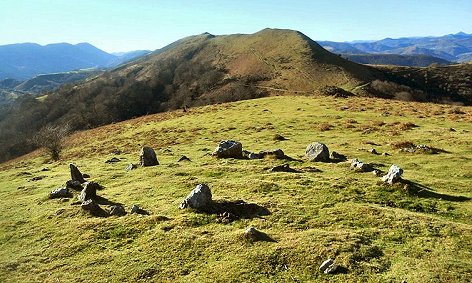
A little stone circle in the remote Basque Pyrenees.
POSTSCRIPTS:
1.BEWARE
OF FAKE CIRCLES
such as those in Ravensdale
Forest, county Louth,
at the tip of the Mullet Peninsula, county
Mayo,
and this one by the roadside just outside Tempo, county Fermanagh.

2. MOURN
MOVED CIRCLES
such as this one near Drimoleague, county Cork,
which has simply been lifted and laid along a field-dyke.
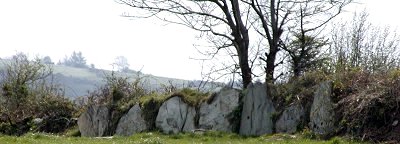
3. RECOMMENDED READING:
Two excellent books on stone circles are:
BURL,
Aubrey: The
Stone Circles of Brittany and
the British Isles, Yale University Press, 2000.
ISBN 0 300 08347 5
This is a book of over 460 pages with a few black-and-white photographs
and detailed text. A few of the Irish townland names are wrongly-spelled.
MILLIGAN,
Max & Aubrey Burl: Circles
of Stone -
The Prehistoric Rings of Britain and Ireland, Harvill 1999.
ISBN 1 86046 661 3
A book of superb photos and succinct texts covering 70 of the most
photogenic circles of the British Isles.
Click on the
thumbnails
to see large
high-
resolution
pictures.

